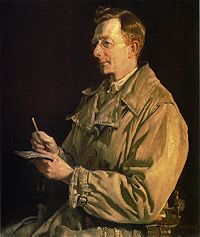Charles Bean
| Charles Bean | |
|---|---|

Portrait by George Lambert, 1924.
|
|
| Native name | Charles Edwin Woodrow Bean |
| Born |
18 November 1879 Bathurst, New South Wales |
| Died | 30 August 1968 (aged 88) Concord, New South Wales |
| Awards | Chesney Gold Medal (1930) |
| Academic background | |
| Alma mater | University of Oxford |
| Influences | Banjo Paterson |
| Academic work | |
| Main interests | Australian military history First World War |
| Notable works | Official History of Australia in the War of 1914–1918 |
| Influenced |
Gavin Long Bill Gammage |
Charles Edwin Woodrow Bean (18 November 1879 – 30 August 1968), usually identified as C.E.W. Bean, was an Australian World War 1 war correspondent and historian.
He is remembered as the Editor of the 12-volume Official History of Australia in the War of 1914–1918 and was instrumental in the establishment of the Australian War Memorial, and of the creation and popularisation of the ANZAC legend.
Bean was born in Bathurst, New South Wales, a son of the Rev. Edwin Bean, headmaster of All Saints' College. In 1889, his family moved to England, where he was educated, firstly at Brentwood School in Essex, of which his father was headmaster, then from 1894 at Clifton College, Bristol, before winning a scholarship in 1898 to Hertford College, Oxford, where he took an MA and B.C.L. and was called to the bar in 1903. He returned to Australia in 1904 and taught briefly, including a stint at Sydney Grammar School, then worked as a legal assistant on a country circuit from 1905 to 1907. He resigned his position as barrister assisting Mr. Justice Owen in May 1907, and recounted his experiences in the The Sydney Morning Herald in a series of articles. In June 1908 he joined the Sydney Morning Herald as a reporter. By mid-1909 he was working on commissioned articles, the first being "The Wool Land" in three weekly instalments. It was during this period of travelling the outback of New South Wales that he took two journeys on the paddle steamer Jandra, which he recounted in Dreadnought of the Darling, serialised in the Sydney Mail 1910, then published in book form 1911. In 1911 and 1912 he was the Herald's correspondent in London. Again, he made good use of his opportunities, producing a series of articles which he fleshed out for his next book Flagships Three, which received favourable reviews.
...
Wikipedia
